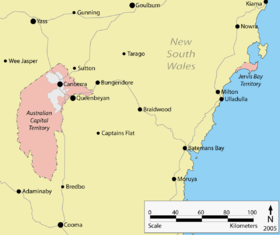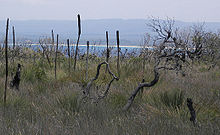- Jervis Bay Territory
-
The Jervis Bay Territory is a territory of the Commonwealth of Australia. It was surrendered by the state of New South Wales to the Commonwealth Government in 1915[1][2] so that the Federal capital at Canberra would have "access to the sea".[3]
It was administered by the Department of the Interior and later, the Department of the Capital Territory as if it were part of the Australian Capital Territory (ACT), although it was always a separate Commonwealth territory. The perception that it is part of the ACT stems from the fact that under the terms of the Jervis Bay Territory Acceptance Act, the laws of the ACT apply to the Jervis Bay Territory.[4]
In 1989, when the ACT achieved self government, the Department of The Arts, Sport, The Environment, Tourism and Territories took over responsibility for the JBT's administration, and it has since been administered by various Commonwealth Departments responsible to the Minister for Territories.
Contents
Etymology
Jervis Bay is named after the British Admiral John Jervis, 1st Earl of St Vincent. Jervis was believed to have pronounced his name /ˈdʒɑrvɨs/, and the pronunciation used in most parts of Australia is /ˈdʒɑːvəs/, but most residents of Jervis Bay pronounce it [ˈdʒɜːvəs].[5]
History
The first European to visit the area was John Oxley, an English explorer and surveyor, in 1819.
Administration
Jervis Bay Territory is currently administered by the Department of Regional Australia, Regional Development and Local Government. However, it is counted as part of the ACT for the purpose of the ACT's representation in the Senate; and it forms part of the Division of Fraser for House of Representatives purposes. The Department of Regional Australia has proposed returning Jervis Bay Territory to New South Wales .[6].
An estimated 394 people live in the territory, the majority working and living at the Royal Australian Navy base, HMAS Creswell.[7] Over 90% of the territory is now legally recognised as Aboriginal land. There is an Aboriginal community at Wreck Bay in the Booderee National Park.
For most purposes, the territory is governed under the laws of the Australian Capital Territory (ACT), by the Jervis Bay Administration, which handles matters normally concerned with local or state government, and provides primary school teachers and Australian Federal Police staffing. Residents have access to the courts of the ACT, but are not separately represented in the ACT Legislative Assembly. The Jervis Bay Territory is in the Commonwealth Electoral Division of Fraser (ACT). Jervis Bay Territory residents are not represented at the local or State government level but have access to the decision-making process through community organisations.
The Defence Force Discipline Act (DFDA) Section 62 makes all Australian Defence Force members and civilian employees subject to the criminal laws of the Jervis Bay Territory regardless of where the offence occurred. This is a legal device which makes Defence personnel subject to the Crimes Act 1914 (Cth), the Criminal Code Act 1995 (Cth) and offences against the criminal law of the ACT, as military law, even if the offence is committed outside Australia.
Vincentia is the nearest town, roughly 3 km north of the border, population 2,750.
Geography
At 67 km2 (26 sq mi) Jervis Bay is the smallest territory of Australia. Jervis Bay is a natural harbour 16 km (10 mi) north-south and 10 km (6 mi) east-west, opening to the east onto the Pacific Ocean. The bay is situated about 150 km (93 mi) south of the city of Sydney, on the southern coast of New South Wales. The nearest city is Nowra, about 40 km (25 mi) (30 minutes' drive) away, on the Shoalhaven River to the north. The majority of Jervis Bay embayment is part of Jervis Bay Marine Park (NSW State) but the waters within JB Territory are part of Booderee National Park (Commonwealth). [Booderee National Park was formerly known as Jervis Bay National Park (Cwlth)].
A wide variety of flora and fauna are native to the Booderee (aboriginal: bay of plenty) National Park with approximately 206 species of birds, 27 species of mammals, 15 species of amphibians, 23 species of reptiles and 180 species of fish native to the area. The park itself encompasses approximately 90% of the territory of Jervis Bay and covers the overlap between Australia's northern and southern climatic zones.
Ancient sand dunes overlay the sedimentary bedrock formations formed from upheaval of the surrounding marine environment 280-225 million years ago. The park was designated sacred Aboriginal land in 1995. A significant portion of the bay's northern coast and headland forming Beecroft Peninsula and ending at Point Perpendicular and surrounding area is a gun bombardment range for the Royal Australian Navy (RAN).
There are three small lakes within the territory: Lake Windermere (the largest, with an area 31 hectares), Lake Mckenzie (7 ha), and Blacks Waterhole (1.4 ha).
Bowen Island, at the entrance to the bay 230 meters north of Governors Head, is 51 ha in area. It has rookeries for the Fairy Penguin (Eudyptula minor) at the northern extent of its range.
Towns and villages in the Territory
There are two towns or villages in the Jervis Bay Territory. They are all covered by postcode 2540. Listed from north to south, they are:
- Jervis Bay Village (pop. 250)
- Wreck Bay Village (pop. 215, part of Jervis Bay Village)
Other villages and towns on the bay are: Hyams Beach, Vincentia, Huskisson, Culburra, Callala Bay, Callala Beach and Myola.
HMAS Creswell
Within the Booderee National Park is HMAS Creswell, the Royal Australian Navy College named after Sir William Rooke Creswell, the Director of the Commonwealth Naval Forces which later became the RAN. The Jervis Bay Airfield is adjacent, operated by the RAN to support its Kalkara (Storm Petrel) pilotless target aircraft (Beech / BAe MQM-107 E). Kalkara are launched from the airfield and later recovered by parachute into the water and thence by boats maintained at HMAS Creswell, after target-towing exercises off the coast with ships or aircraft. Control equipment is sited at Bherwerre Ridge overlooking the sea to the east.[citation needed]
Nuclear reactor site
Of historical interest is the site of the proposed Jervis Bay Nuclear Power Plant. The site is near Murray's Beach, at the southeast corner of the Bay. The project was cancelled in 1971 after site works (excavation and levelling) were done and a road was constructed to the territory border. The levelled site is now the car park for Murrays Beach and its adjacent boat ramp.
See also
- Jervis Bay Airport
- Jervis Bay (Australia)
- HMS Jervis Bay (F40)
- HMAS Jervis Bay (GT-203)
- South Coast Pipe (famous surf break)
References
- ^ http://www.comlaw.gov.au/ComLaw/Legislation/ActCompilation1.nsf/0/1442C4694523DB70CA256F71004C5B1C?OpenDocument (and amendments)
- ^ http://www.foundingdocs.gov.au/item.asp?sdID=126
- ^ http://www.foundingdocs.gov.au/enlargement.asp?eID=105&pID=95#
- ^ http://www.ag.gov.au/www/agd/agd.nsf/Page/TerritoriesofAustralia_JervisBay_JervisBayGovernanceandAdministration
- ^ Macquarie Dictionary, Fourth Edition (2005). Melbourne, The Macquarie Library Pty Ltd. ISBN 1-876429-14-3
- ^ "Documents flag returning Jervis Bay to NSW law". Canberra Times. 4 July 2011. http://www.canberratimes.com.au/news/local/news/general/documents-flag-returning-jervis-bay-to-nsw-law/2214637.aspx.
- ^ Australian Bureau of Statistics (30 March 2010). "Regional Population Growth, Australia, 2008–09". http://www.abs.gov.au/AUSSTATS/abs@.nsf/DetailsPage/3218.02008-09?OpenDocument. Retrieved 5 June 2010.
External links
- Jervis Bay Territory is at coordinates 35°09′05″S 150°41′16″E / 35.151354°S 150.68779°ECoordinates: 35°09′05″S 150°41′16″E / 35.151354°S 150.68779°E
South Coast, New South Wales Cities: Townships: Basin View · Batehaven · Batemans Bay · Bawley Point · Bega · Bemboka · Bermagui · Berry · Bodalla · Boydtown · Broulee · Callala Bay · Candelo · Cobargo · Congo · Culburra Beach · Dalmeny · Eden · Greenwell Point · Huskisson · Hyams Beach · Kianga · Kioloa · Lake Conjola · Malua Bay · Manyana · Merimbula · Milton · Mogo · Mollymook · Moruya · Mystery Bay · Narooma · Nelligen · Nerrigundah · Pambula · Pambula Beach · Potato Point · Pyree · Rosedale · Sanctuary Point · South Durras · St Georges Basin · Tathra · Tilba · Towamba · Tura Beach · Tuross Head · Ulladulla · Vincentia · Wandandian · Wolumla · WonboynLocal Government Areas: National Parks: Ben Boyd · Bournda · Biamanga · Budawang · Clyde River · Conjola · Deua · Eurobodalla · Gulaga · Jerrawangala · Kooraban · Mimosa Rocks · Monga · Morton · Mount Imlay · Murramarang · South East Forest · WadbilligaStates and territories of Australia States and mainland
territories
External territories Former territories History of Australia States Territories - Australian Capital Territory
- Jervis Bay Territory
- Northern Territory
External territories - Ashmore and Cartier Islands
- Australian Antarctic Territory
- Christmas Island
- Cocos (Keeling) Islands
- Coral Sea Islands
- Heard Island and McDonald Islands
- Norfolk Island
Geography of Australia States - New South Wales
- Queensland
- South Australia
- Tasmania
- Victoria
- Western Australia
Territories - Australian Capital Territory
- Jervis Bay Territory
- Northern Territory
External territories - Ashmore and Cartier Islands
- Australian Antarctic Territory
- Christmas Island
- Cocos (Keeling) Islands
- Coral Sea Islands
- Heard Island and McDonald Islands
- Norfolk Island
Categories:- Jervis Bay Territory
- Bays of Australia
- Exclaves
- Shoalhaven
- South Coast, New South Wales
- States and territories of Australia
- States and territories established in 1989
Wikimedia Foundation. 2010.






